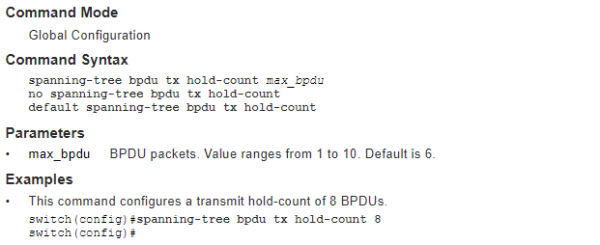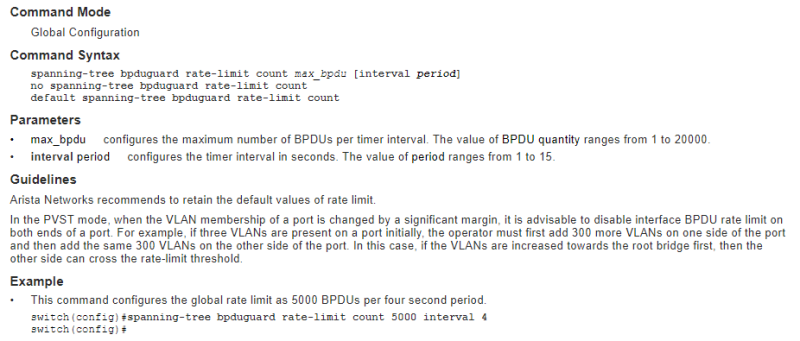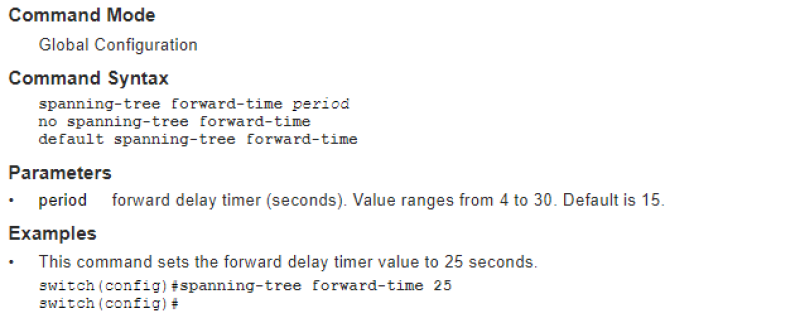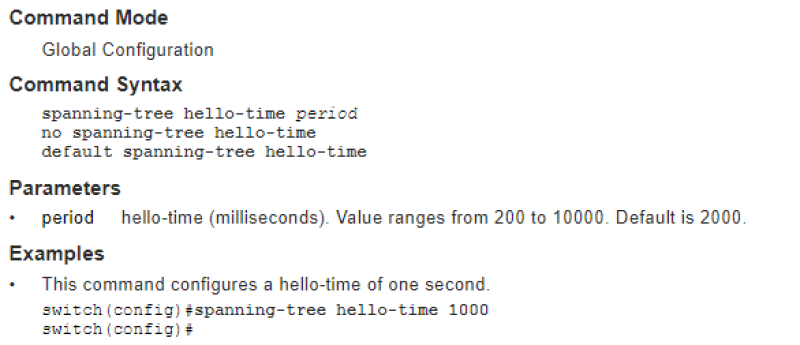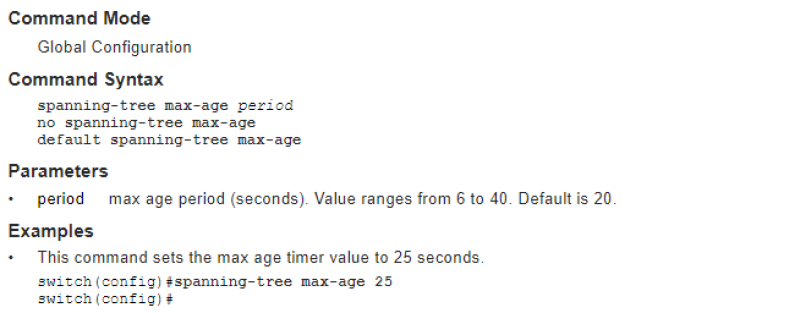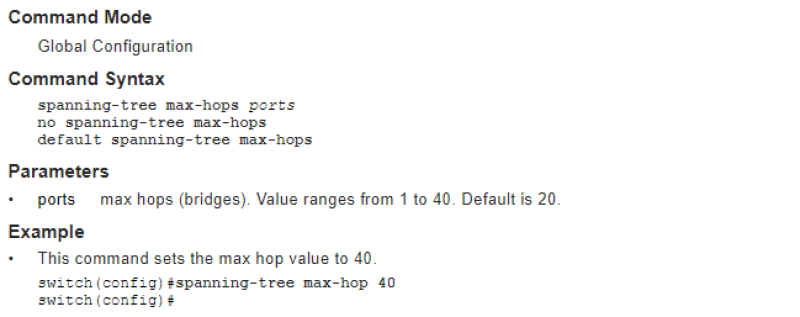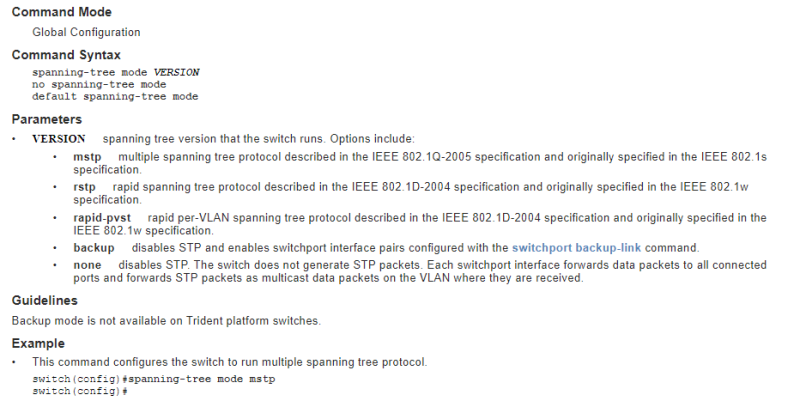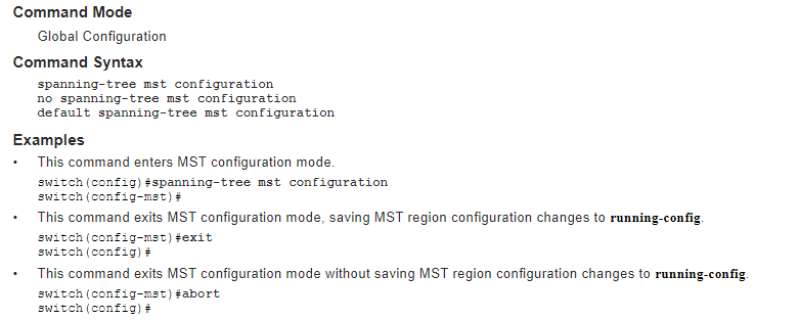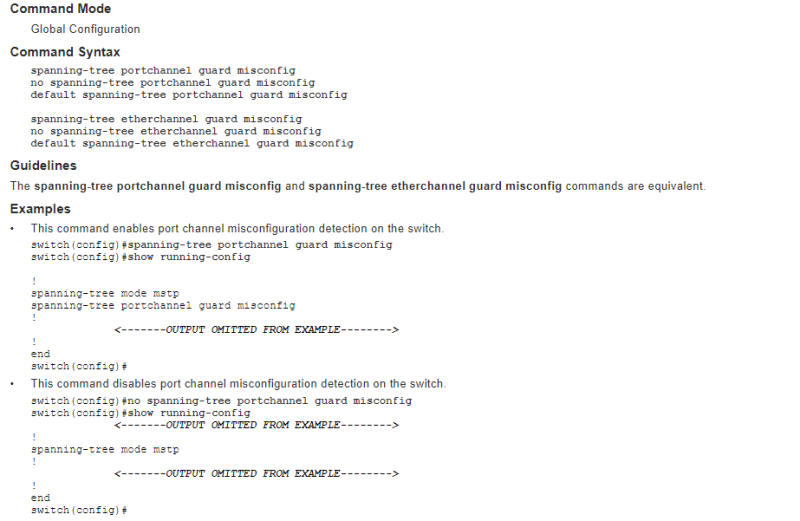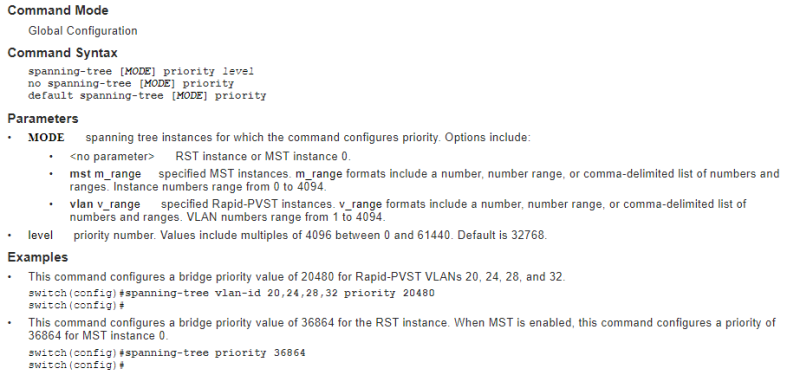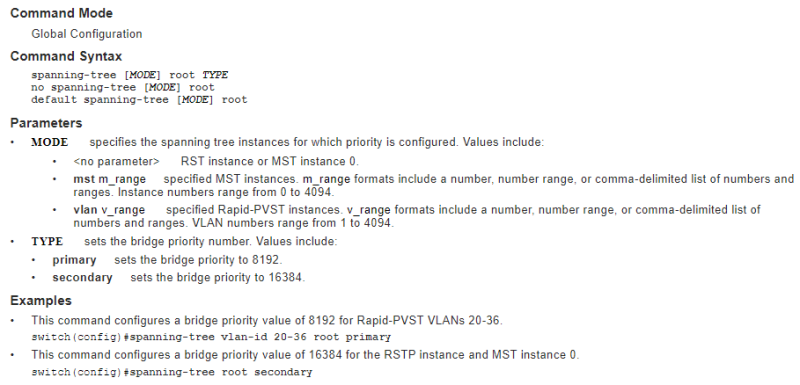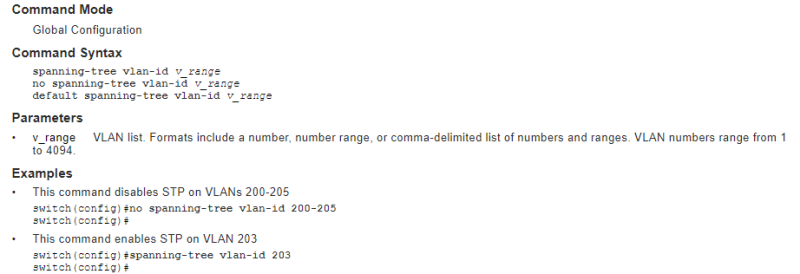This is an old revision of the document!
Table of Contents
STP COMMANDS
Spanning Tree Commands: Global Configuration
spanning-tree bpdu tx hold-count
The spanning-tree bpdu tx hold-count command specifies the maximum number of BPDUs per second that the switch can send from an interface. Valid settings range from 1 to 10 BPDUs with a default of 6 BPDUs.
The no spanning-tree bpdu tx hold-count and default spanning-tree bpdu tx hold-count commands restore the transmit hold count default of 6 BPDUs by removing the spanning-tree bpdu tx hold-count command from running-config.
Spanning-tree bpduguard rate-limit default
The spanning-tree bpduguard rate-limit default command configures the global BPDU rate limit setting. The global BPDU rate limit setting provides the default for individual ports whose configuration does not include a spanning-tree bpduguard rate-limit enable / disable command. The default global setting is enabled.
BPDU rate limiting restricts the number of BPDUs that ports with BPDU guard or BPDU filter disabled can process during a specified interval. Ports discard BPDUs it receives in excess of the specified limit. BPDU rate limits are established by spanning-tree bpduguard rate-limit count (global) commands.
The no spanning-tree bpduguard rate-limit default sets the global BPDU rate limit setting to disabled. The spanning-tree bpduguard rate-limit default and default spanning-tree bpduguard rate-limit default commands restore the default global rate limit setting to enabled by removing the no spanning-tree bpduguard rate-limit default command from running-config.
spanning-tree bpduguard rate-limit count (global)
The spanning-tree bpduguard rate-limit count command sets the maximum BPDU reception rate (quantity per interval) for ports that are not covered by a spanning-tree bpduguard rate-limit count (interface) command.
BPDU rate limiting restricts the number of BPDUs that ports with BPDU guard or BPDU filter disabled can process during a specified interval. Ports discard BPDUs they receive in excess of the specified limit. BPDU rate limiting is enabled or disabled by spanning-tree bpduguard rate-limit enable / disable commands.
The no spanning-tree bpduguard rate-limit count and default spanning-tree bpduguard rate-limit count commands restore the global setting to its default value by removing the spanning-tree bpduguard rate-limit count command from running-config.
spanning-tree edge-port bpdufilter default
The spanning-tree edge-port bpdufilter default command configures the global BPDU filter setting as enabled. Ports not covered by a spanning-tree bpdufilter command use the global BPDU filter setting.
spanning-tree edge-port bpduguard default
The spanning-tree edge-port bpduguard default command sets the global BPDU guard setting as enabled. Ports not covered by a spanning-tree bpduguard command use the global BPDU guard setting.
spanning-tree forward-time
The spanning-tree forward-time command configures the forward delay timer. Forward delay is the time that a port is in learning state before it begins forwarding data packets.
The switch inserts the forward delay timer value in BPDU packets it sends as the root bridge. The forward delay value ranges from 4 to 30 seconds with a default of 15 seconds.
The no spanning-tree forward-time and default spanning-tree forward-time commands restore the forward delay timer default of 15 seconds by removing the spanning-tree forward-time command from running-config.
spanning-tree guard loop default
The spanning-tree guard loop default command configures the global loop guard setting as enabled. Ports not covered by a spanning-tree guard command use the global loop guard setting. Loop guard prevents blocked or root ports from becoming a designated port due to failures resulting in a unidirectional link. The spanning-tree guard interface configuration statement overrides the global setting for a specified interface. The default global loop guard setting is disabled.
The no spanning-tree guard loop default and default spanning-tree guard loop default commands restore the global loop guard setting of disabled by removing the spanning-tree guard loop default command from running-config.
spanning-tree hello-time
The spanning-tree hello-time command configures the hello time, which specifies the transmission interval between consecutive bridge protocol data units (BPDU) that the switch sends as a root bridge. The hello time is also inserted in outbound BPDUs.
This hello time ranges from 0.2 seconds to 10 seconds with a default of 2 seconds. The no spanning-tree hello-time and default spanning-tree hello-time commands restore the hello time default of 2 seconds by removing the spanning-tree hello-time command from running-config.
spanning-tree max-age
The spanning-tree max-age command configures the switch’s max age timer, which specifies the max age value that the switch inserts in outbound BPDU packets it sends as a root bridge. The max-age time value ranges from 6 to 40 seconds with a default of 20 seconds.
Max age is the interval, specified in the BPDU, that BPDU data remains valid after its reception. The bridge recomputes the spanning tree topology if it does not receive a new BPDU before max age expiry.
The no spanning-tree max-age and default spanning-tree max-age commands restore the max-age default of 20 seconds by removing the spanning-tree max-age command from running-config.
spanning-tree max-hops
The spanning-tree max-hops command specifies the max hop setting that the switch inserts into BPDUs that it sends out as the root bridge. The max hop setting determines the number of bridges in an MST region that a BPDU can traverse before it is discarded. The max-hop value ranges from 1 to 40 with a default of 20.
The no spanning-tree max-hops and default spanning-tree max-hops commands restore the max-hops setting to its default value of 20 by removing the spanning-tree max-hops command from running-config.
spanning-tree mode
The spanning-tree mode command specifies the spanning tree protocol version that the switch runs. The default mode is Multiple Spanning Tree (mstp).
The no spanning-tree mode and default spanning-tree mode commands restore the default spanning tree protocol version.
Caution: The spanning-tree mode command may disrupt user traffic. When the switch starts a different STP version, all spanning-tree instances are stopped, then restarted in the new mode.
spanning-tree mst configuration
The spanning-tree mst configuration command places the switch in MST-configuration mode, which is the group change mode where MST region parameters are configured.
Changes made in a group change mode are saved by leaving the mode through the exit command or by entering another configuration mode. To discard changes from the current edit session, leave the mode with the abort command.
spanning-tree mst pvst border
The spanning-tree mst pvst border command configures MSTP PVST border feature to automatically detect border ports facing PVST+ regions. By default, spanning-tree mst pvst border is disabled.
The no spanning-tree mst pvst border and default spanning-tree mst pvst border commands restore the default MST configuration.
spanning-tree portchannel guard misconfig
The spanning-tree portchannel guard misconfig command enables the switch to detect misconfigured port channels that may cause network loops by monitoring inbound BPDUs. When a port channel receives 75 inconsistent BPDUs within 30 seconds, the switch error disables the port. When a port channel receives 5 BPDUs with the same source BPDU during the 30 second measurement interval, the error counter is reset and the port continues normal port channel operation. Misconfigured port channel detection is disabled by default.
The no spanning-tree portchannel guard misconfig and default spanning-tree portchannel guard misconfig commands disables the detection of misconfigured port channels by removing the spanning-tree portchannel guard misconfig statement from running-config
spanning-tree priority
The spanning-tree priority command configures the bridge priority number. The bridge priority is the four most significant digits of the bridge ID, which is used by spanning tree algorithms to select the root bridge and choose among redundant links. Bridge ID numbers range from 0 to 65535 (16 bits); bridges with smaller bridge IDs are elected over other bridges.
Because bridge priority sets the four most significant bits of the bridge ID, valid settings include all multiples of 4096 between 0 and 61440. Default value is 32768.
The spanning-tree priority command provides a mode option:
•RST instance priority is configured by not including a mode.
•MST instance 0 priority is configured by not including a mode or with the mst mode option.
•MST instance priority is configured with the mst mode option.
•Rapid-PVST VLAN priority is configured with the vlan mode option.
The no spanning-tree priority and default spanning-tree priority commands restore the bridge priority default of 32768 for the specified mode by removing the corresponding spanning-tree priority command from running-config.
Another method of adding spanning-tree priority commands to the configuration is through the spanning-tree root command. Similarly, the no spanning-tree root command removes the corresponding spanning-tree priority command from running-config.
spanning-tree root
The spanning-tree root command configures the bridge priority number by adding a spanning-tree priority command to the configuration. Parameter settings set the following priority values:
•primary sets the bridge priority to 8192.
•secondary sets the bridge priority to 16384.
The bridge priority is the four most significant digits of the bridge ID, which is used by spanning tree algorithms to select the root bridge and choose among redundant links. Bridge ID numbers range from 0 to 65535 (16 bits); bridges with smaller bridge IDs are elected over other bridges.
When no other switch in the network is similarly configured, assigning the primary value to the switch facilitates its selection as the root switch. Assigning the secondary value to the switch facilitates its selection as the backup root in a network that contains one switch with a smaller priority number.
The spanning-tree root command provides a mode option:
•RST instance priority is configured by not including a mode.
•MST instance 0 priority is configured by not including a mode or with the mst mode option.
•MST instance priority is configured with the mst mode option.
•Rapid-PVST VLAN priority is configured with the vlan mode option.
The no spanning-tree root and default spanning-tree root commands restore the bridge priority default of 32768 by removing the corresponding spanning-tree priority command from running-config. The no spanning-tree root, no spanning-tree priority, default spanning-tree root and default spanning-tree priority commands perform the same function.
spanning-tree transmit active
The spanning-tree transmit active command enables bridge assurance globally, which enables bridge assurance on all ports with a port type of network. Bridge assurance protects against unidirectional link failure, other software failure, and devices that quit running a spanning tree algorithm.
Bridge assurance is available only on point-to-point links on spanning tree network ports. Both ends of the link should ideally have bridge assurance enabled. Bridge assurance-enabled ports will not necessarily be blocked when they link to a port where bridge assurance is not enabled, but if they do not receive periodic BPDUs from the other side of the link the show spanning-tree transmit active command will show a bridge assurance status of “inconsistent” (blocking) for that port.
The no spanning-tree transmit active command disables bridge assurance. The spanning-tree transmit active and default spanning-tree transmit active commands restore the default behavior by removing the no spanning-tree transmit active command from running-config.
spanning-tree vlan-id
The spanning-tree vlan-id command enables Spanning Tree Protocol (STP) on specified VLANs by removing any corresponding no spanning-tree vlan-id statements from running-config. Spanning-tree is enabled on all VLANs by default.
The no spanning-tree vlan-id command disables STP on the specified interfaces. The default spanning-tree vlan-id enables STP on the specified interfaces.
Warning: Disabling STP is not recommended, even in topologies free of physical loops; STP guards against configuration mistakes and cabling errors. When disabling STP, ensure that there are no physical loops in the VLAN.
Important! When disabling STP on a VLAN, ensure that all switches and bridges in the network disable STP for the same VLAN. Disabling STP on a subset of switches and bridges in a VLAN may have unexpected results because switches and bridges running STP will have incomplete information regarding the network's physical topology.
Loop Protection Commands
disabled-time
The disabled-time command sets the time for which the port remains disabled after a loop is detected by loop protection. The no disabled-time and default disabled-time commands reset the disabled time to the default of 604800 seconds (seven days).
Note: If this value is changed, interfaces that are already disabled by loop protection will remain disabled for the previously configured period.
loop-protection
The loop-protection command enables loop protection on the configuration mode interface. All interfaces in a VLAN under loop protection have loop protection enabled by default. The no loop-protection and default loop-protection commands disable loop protection on the interface.
When loop protection is disabled (at the VLAN or interface level), the computed state of the interface is forgotten and packets queued to be sent are dropped. If an interface is err-disabled by loop protection, disabling loop protection removes the err-disable.

